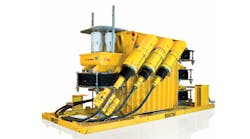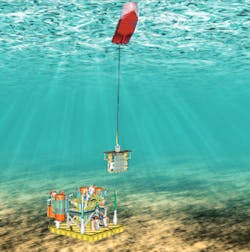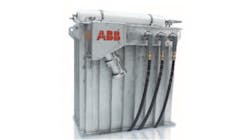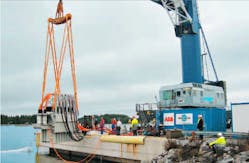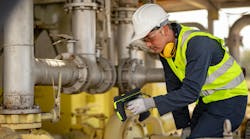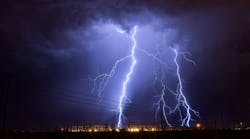ABB is an innovator in subsea electrical solutions and has been involved in the development of subsea electrical equipment for many years. Feasibility studies on subsea components began in 1984 and the first commercial subsea transformer was delivered in 1998. Since then, ABB has delivered transformers and variable speed drive systems to some of the largest and most advanced offshore developments in the world.
Subsea transformers from ABB are engineered to provide superior performance and cost benefits for offshore developments that have subsea rotating equipment located far from the nearest available power supply.
The ABB subsea transformer is a liquid-filled, pressure-compensated unit suitable for power supply operations in deepwater fields. The pressure-compensating system keeps the internal pressure close to that of the outside water by immersing the internals in liquid and eliminating all air- and gas-filled voids. Cooling is provided inherently through natural convection. The unit can be delivered with a single or double shell and has been qualified for depths of up to 3,000 meters.
Subsea transformers from ABB are used with a range of subsea equipment: boosters, pumps, compressors, pipeline heating systems, electrical distribution systems, frequency converters and wave hubs. Subsea environments are extreme, hazardous and costly places even to reach, let alone to use as sites for industrial equipment ➔ 1. Why is it necessary to install and operate equipment at the bottom of the sea?
1 Ever more equipment is being placed on the sea bed
The deepwater frontier
The exploitation of offshore oil in shallow waters is declining as these relatively local reserves diminish. Often, to maximize oil extraction, seawater or gas is pumped into the well to increase pressure and drive out the remaining fuel trapped beneath the seabed.
Similar techniques are used in deepwater oil fields. As these are at much greater distances from the shore, they present additional challenges to the industry. Operations here require specialized knowledge and expertise, particularly when powering compressors, pumps and motors at depths of several kilometers, possibly 50 or 100 km away from the shore.
Subsea technology makes oil and gas production possible at a depth of several kilometers and pressure-increasing compressors enable continued production in waning oil and gas fields. The performance levels required of deep-sea equipment are very high and reliability is decisive.
Bringing low-loss power to remote offshore locations requires transmission at high voltage through subsea cables. Such transmission relies on step-up transformers to increase the voltage levels for transmission and step-down transformers to reduce the voltage to a level suitable for the specialist electrical equipment at the offshore site.
Underwater oil fields present some of the most extreme environments imaginable for transformers. ABB remains the world's leading manufacturer of subsea transformers, with many examples powering pumps and compressors that extract oil and gas from reservoirs below the seabed, thus keeping wells productive longer.
Since this specialized equipment operates deep beneath the surface of the sea, the step-down transformer must be able to operate at these depths too. ABB subsea transformers require specialized design features that enable them to operate at depth, under pressure. This means all disair- and gas-filled voids within the outer casing must be eliminated by immersing components in liquid and a pressure compensating system, to keep the internal pressure close to the outside water pressure, has to be available ➔ 2.
2 1.6 MVA subsea transformer for multiphase oil pump
Since transformers get hot when they run, the type of liquid used inside the transformer is critical to its successful operation. The high quality insulating oil used has a low expansion coefficient and high compatibility with the other materials and components used in the transformer. Since the transformer is housed in a solid tank that cannot expand, even when hot, the oil is degassed prior to installation. The heat generated by the transformer during operation has the potential to accelerate chemical reactions, possibly enhancing the corrosive effects of seawater, and, since the transformer is cooled by natural convection, also the potential to attract living organisms to the outer surface of the casing. These factors necessitate the use of special, high-grade steel for the casing, which must also be able to cope with the high pressures associated with deep-sea locations. The largest subsea transformers so far are about 4 m tall, 7 m long and 3 m wide, and contain about 14 m3 of insulating oil ➔ 3.
3 A 16.5 MVA transformer being submerged for a heat run and system testing at Vaasa harbor, Finland. The three 22 kV penetrators and two low voltage signal connectors are visible
Including pigtail cables, connectors and compensators, the entire unit can weigh about 60 metric tons and would most likely sink into the mud or sand if it were simply lowered onto the seabed. The entire structure is, therefore, mounted on strong piles hammered into the seabed. Tubes on the underside of the structure slot over the piles so that the structure stands a few meters above the seabed when properly installed.
Once installed on the seabed, no further maintenance is required. In fact, since the scope for doing repairs is limited, due to the expense of raising equipment to the surface, ABB has invested a great deal of time and effort to ensure all components are of the highest quality and have undergone rigorous testing. These stringent tests have ensured that all 20 ABB subsea transformers currently installed are operating reliably and safely and are providing great performance and cost benefits to offshore developments.
Gulf of Mexico project
In the Gulf of Mexico, at a depth of about 2,000 meters, an oil pipeline has to be warmed in order to de-solidify oil that has congealed due to pressure and cold caused by an unplanned production shutdown. A mobile plant, consisting of an electrical system, a subsea cable and a subsea skid, will be transported by ship to the place where the pipeline has frozen. The subsea skid, which will include a subsea transformer and the electrical connectors required to make contact with the pipeline, will be lowered to the seabed. With the help of a remotely operated vehicle (ROV) the electrical connectors will be attached to the pipeline and the power switched on. The ship's diesel generator will supply 480 volts and a step-up transformer will be used to raise and regulate the voltage to between 1 kV and 11 kV. On the seabed, the subsea transformer will lower the voltage to a suitable level. The pipeline will then be heated up and after a few days the blockage should dissolve.
Åsgard field project
The most recent subsea transformer technology will ensure continuous production in an Åsgard gas field 400 meters below the surface. Here, building a new offshore platform near the gas field was considered too costly. Moreover, the field is over 150 km from land, and 50 km from the nearest offshore platform. At these distances and using conventional operational voltages (6.6 kV), most of the power required to keep the compressor motors running on the seafloor would be lost. The solution is one of ABB's most recent subsea transformers, a rugged, powerful unit capable of operating at depths of up to three kilometers. With high power and voltage ratings (19 MVA/31 kV/6.6 kV) and a high operating frequency (up to 121 Hz), this specialized transformer is the most efficient on the market and is capable of reliable operation at this site. Åsgard is the first gas field to utilize subsea compressors. ABB is manufacturing nine subsea transformers for this project, scheduled for completion and testing in June 2013.
Wind installations
Large, open-sea wind park installations could use subsea transformers to connect to the mainland grid. Placing a grid connection transformer on the seabed eliminates the need to build a specific transformer platform. Tidal turbine parks and wave-power converter parks could similarly benefit from ABB subsea transformer technology as they become large scale commercialized operations. ABB has already been contacted by developers keen to understand the possibilities of subsea power technologies that relate to their specific applications.
Subsea distribution system (SEPDIS)
SEPDIS was born out of the idea of moving the electrical distribution system down to the seabed. This enables electrical power to be transmitted to the site in question at a high voltage and the distribution system to be located close to end consumers. Electrically, SEPDIS is a conventional transmission and distribution system with a limited number of components and functions. Mechanically, and in terms of its subsea capability, it is a very robust and sophisticated system.
Long transmission cables carrying high voltages produce large amounts of capacitive power. This increases loading on the cable, as well as on other components feeding the power chain. Shunt reactors are commonly used to eliminate this extra load. This means that, in future, subsea shunt reactors will also be needed for subsea transmission and power systems. As a leading manufacturer of shunt reactors for onshore power and transmission systems, ABB is developing this technology for subsea applications as well.
ABB's first two operational subsea transformers, rated at 1.6 MVA 11 kV /1 kV, have been in operation since 1999 at a depth of 500 m. Since then, ABB has been incrementally developing larger units. ABB has built and tested a 60-ton subsea transformer for 20 MVA 132 kV/22.5 kV and 16.5 MVA 22 kV/ 3.5 kV/3.5 kV/2.8 kV. This was delivered to Nyhamna in Norway for testing equipment in the Ormen Lange gas field. Actual use in production is expected to begin in 2014. From a depth of one kilometer, it will feed power to compressors installed to improve gas production. The Ormen Lange field supplies 20 percent of the UK's natural gas via a 1,200 km long undersea pipeline.
ABB remains the world's leading manufacturer of subsea transformers capable of delivering reliable power underwater with minimal losses.
Esa Virtanen
ABB Oy Transformers
Vaasa, Finland
[email protected]
Alper Akdag
ABB Management Services Ltd.
Zurich, Switzerland
[email protected]
